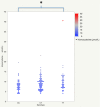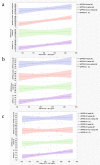One-carbon pathway and cognitive skills in children with Down syndrome
- PMID: 33608632
- PMCID: PMC7895965
- DOI: 10.1038/s41598-021-83379-7
One-carbon pathway and cognitive skills in children with Down syndrome
Abstract
This work investigates the role of metabolite levels in the intellectual impairment of subjects with Down syndrome (DS). Homocysteine, folate, vitamin B12, uric acid (UA), creatinine levels and MTHFR C677T genotype were analyzed in 147 subjects with DS. For 77 subjects, metabolite levels were correlated with cognitive tests. Griffiths-III test was administered to 28 subjects (3.08-6.16 years) and WPPSI-III test was administered to 49 subjects (7.08-16.08 years). Significant correlations were found among some metabolite levels and between homocysteine levels and MTHFR C677T genotype. Moreover, homocysteine, UA and creatinine levels resulted increased with age. We did not find any correlation between metabolites and cognitive test score in the younger group. Homocysteine showed statistically significant correlation with WPPSI-III subtest scores when its level is ≥ 7.35 µmol/L, remaining correlated in higher thresholds only for non-verbal area scores. Vitamin B12 showed correlations with all WPPSI-III subtest scores when its level is < 442 pg/mL. The relevance of the present findings is the detection of a specific metabolite threshold related with a better or worse cognitive score, suggesting that vitamin B12 and homocysteine may have a role in cognitive development in children with DS.
Conflict of interest statement
The authors declare no competing interests.
Figures





References
-
- Lejeune J, Gauthier M, Turpin R. Human chromosomes in tissue cultures. Comptes rendus hebdomadaires des seances de l'Academie des sciences. 1959;248:602–603. - PubMed
-
- Strippoli P, et al. State of the Art of Research on Down Syndrome. Cambridge: Academic Press; 2019. pp. 1–39.
Publication types
MeSH terms
Substances
LinkOut - more resources
Full Text Sources
Other Literature Sources
Medical

